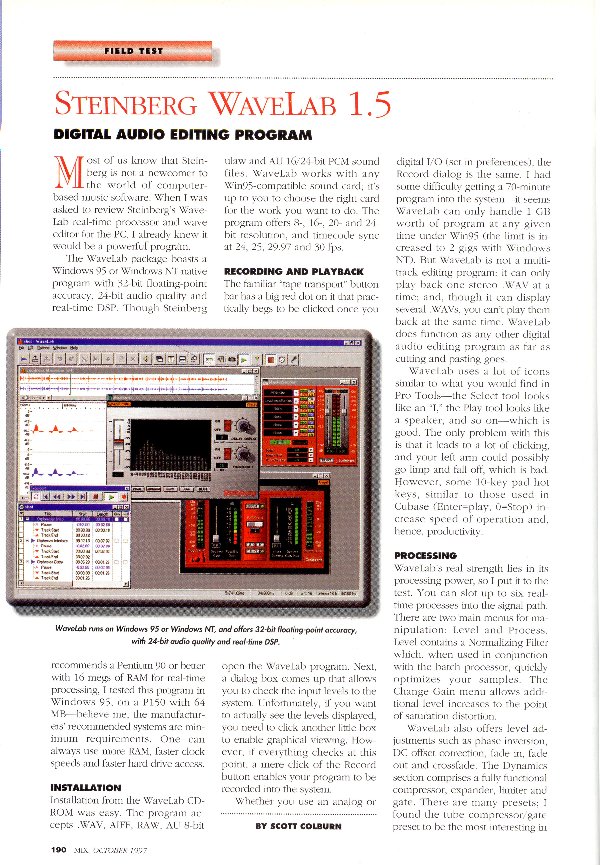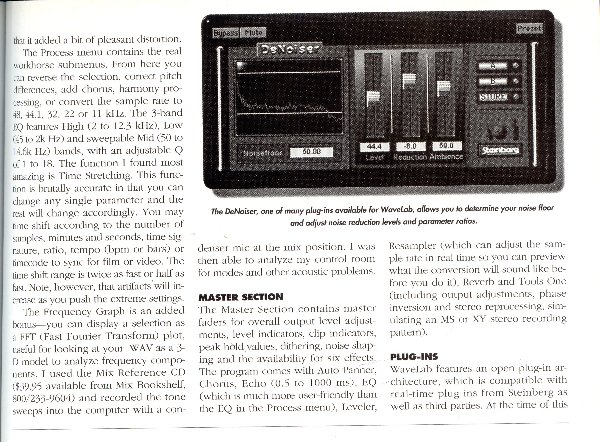


STEINBERG Wavelab 1.5
Digital Audio Editing Software
by Scott Colburn
WaveLab runs on Windows 95 or Windows NT, and offers 32-bit floating-point accuracy, with 24-bit audio quality and real-time DSP.
Most of us know that Steinberg is not a newcomer to the world of computer-based music software. When I was asked to review Steinberg's WaveLab real-time processor and wave editor for the PC, I already knew it would be a powerful program.
The WaveLab package boasts a Windows 95 or Windows NT-native program with 32-bit floating-point accuracy, 24-bit audio quality and real-time DSP. Though Steinberg recommends a Pentium 90 or better with 16 megs of RAM for real-time processing, I tested this program in Windows 95, on a P150 with 64 MB--believe me, the manufacturers' recommended systems are minimum requirements. One can always use more RAM, faster clock speeds and faster hard drive access.
INSTALLATION
Installation from the WaveLab CD-ROM was easy. The program accepts .WAV, AIFF, RAW, AU 8-bit ulaw and AU 16/24-bit PCM sound files. WaveLab works with any Win95-compatible sound card; it's up to you to choose the right card for the work you want to do. The program offers 8-, 16-, 20- and 24-bit resolution, and timecode sync at 24, 25, 29.97 and 30 fps.
RECORDING AND PLAYBACK
The familiar "tape transport" button bar has a big red dot on it that practically begs to be clicked once you open the WaveLab program. Next, a dialog box comes up that allows you to check the input levels to the system. Unfortunately, if you want to actually see the levels displayed, you need to click another little box to enable graphical viewing. However, if everything checks at this point, a mere click of the Record button enables your program to be recorded into the system.
Whether you use an analog or digital I/O (set in preferences), the Record dialog is the same. I had some difficulty getting a 70-minute program into the system--it seems WaveLab can only handle 1 GB worth of program at any given time under Win95 (the limit is increased to 2 gigs with Windows NT). But WaveLab is not a multitrack editing program: it can only play back one stereo .WAV at a time; and, though it can display several .WAVs, you can't play them back at the same time. WaveLab does function as any other digital audio editing program as far as cutting and pasting goes.
WaveLab uses a lot of icons similar to what you would find in Pro Tools--the Select tool looks like an "I," the Play tool looks like a speaker, and so on--which is good. The only problem with this is that it leads to a lot of clicking, and your left arm could possibly go limp and fall off, which is bad. However, some 10-key pad hot keys, similar to those used in Cubase (Enter=play, 0=Stop) increase speed of operation and, hence, productivity.
PROCESSING
WaveLab's real strength lies in its processing power, so I put it to the test. You can slot up to six real-time processes into the signal path. There are two main menus for manipulation: Level and Process. Level contains a Normalizing Filter which, when used in conjunction with the batch processor, quickly optimizes your samples. The Change Gain menu allows additional level increases to the point of saturation distortion.
WaveLab also offers level adjustments such as phase inversion, DC offset correction, fade in, fade out and crossfade. The Dynamics section comprises a fully functional compressor, expander, limiter and gate. There are many presets; I found the tube compressor/gate preset to be the most interesting in that it added a bit of pleasant distortion.
The Process menu contains the real workhorse submenus. From here you can reverse the selection, correct pitch differences, add chorus, harmony processing, or convert the sample rate to 48, 44.1, 32, 22 or 11 kHz. The 3-band EQ features High (2 to 12.3 kHz), Low (45 to 2k Hz) and sweepable Mid (50 to 14.6k Hz) bands, with an adjustable Q of 1 to 18. The function I found most amazing is Time Stretching. This function is brutally accurate in that you can change any single parameter and the rest will change accordingly. You may time shift according to the number of samples, minutes and seconds, time signature, ratio, tempo (bpm or bars) or timecode to sync for film or video. The time shift range is twice as fast or half as fast. Note, however, that artifacts will increase as you push the extreme settings.
The Frequency Graph is an added bonus--you can display a selection as a FFT (Fast Fourier Transform) plot, useful for looking at your .WAV as a 3-D model to analyze frequency components. I used the Mix Reference CD ($39.95 available from Mix Bookshelf, 800/233-9604) and recorded the tone sweeps into the computer with a condenser mic at the mix position. I was then able to analyze my control room for modes and other acoustic problems.
MASTER SECTION
The Master Section contains master faders for overall output level adjustments, level indicators, clip indicators, peak hold values, dithering, noise shaping and the availability for six effects. The program comes with Auto Panner, Chorus, Echo (0.5 to 1000 ms), EQ (which is much more user-friendly than the EQ in the Process menu), Leveler, Resampler (which can adjust the sample rate in real time so you can preview what the conversion will sound like before you do it), Reverb and Tools One (including output adjustments, phase inversion and stereo reprocessing, simulating an MS or XY stereo recording pattern).
The De-Noiser, one of many plug-ins available for WaveLab, allows you to determine your noise floor and adjust noise reduction levels and parameter ratios.
PLUG-INS
WaveLab features an open plug-in architecture, which is compatible with real-time plug-ins from Steinberg as well as third parties. At the time of this review, Steinberg offered five plug-ins ($399 each) for WaveLab. Unfortunately, these plug-ins require a dongle to be attached to the parallel port (you should see the tail my Zip drive has out the back!); however, Steinberg says future plug-ins won't require dongles. The installation disc features a bonus plug-in called the Grungelizer (and no, it doesn't make everything sound like Mudhoney). This plug-in operates in a very intuitive manner--you get six knobs to turn: one adds surface noise to make your .WAV sound like a 45, 33 or 78; Noise adds tape hiss; Distortion needs no explanation; EQ allows you to make your piece sound more and more like it's coming out of a Victrola; AC allows the introduction of 50- or 60-cycle hum; and Time Line is like the Tardis of audio, allowing you to travel back in time to the 1900s.
The DeClicker allows you to remove clicks from vinyl, but it can also be used to remove pick clicks or mouth noises. I tried this on an old 78 and monitored the filter, and was amazed by the results! The DeNoiser allows you to find a noise floor and adjust the level of reduction.
The Spectralizer adds in 2nd and 3rd harmonics based on frequency. Note that stereo processing requires an extremely fast computer for real time.
The Loudness Maximizer combines limiting and compression without altering the spectral content to maximize your level, similar to the processing used in radio broadcasts.
CONCLUSION
Steinberg WaveLab is a fully functional, clean, professional and fairly easy-to-use stereo editor. As a mastering/digital editing program, this is a fast and useful way to add that extra sparkle or final polish on the boot that will kick your production to the moon. [Late breaking news: Steinberg is now shipping WaveLab 1.6, which offers CD-burning capability and Microsoft ActiveMovie support. Version 1.6 retails for $499; the upgrade is free to Version 1.5 users, $99 to Version 1.0 users.--Ed.]





